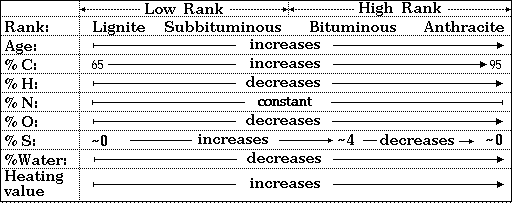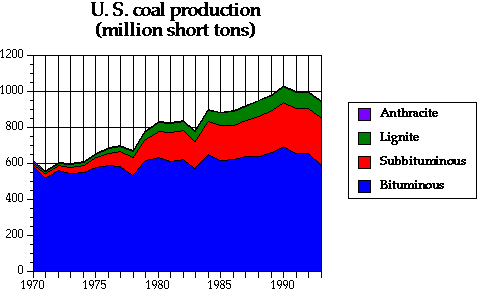
Coal is an organic rock (in contrast to most other rocks in the Earth's crust, which are inorganic). Its molecular structure is very complex. Fortunately, we don't need to analyze this structure in order to understand coal's virtues and vices. What we do need is a knowledge of coal's elemental analysis. In other words, we need to know only how much carbon, hydrogen, sulfur, oxygen and nitrogen there is in a given coal.
A typical elemental analysis of a bituminous coal is as follows: 82% carbon, 5% hydrogen, 1% nitrogen, 3% sulfur, 9% oxygen. Let's use it to derive an approximate and convenient 'molecular formula' for coal. This will allow us to understand why the potential greenhouse effect of coal is greater than that of oil or natural gas.

The above figure summarizes the principal properties of coals. Low-rank coals (lignites and subbituminous coals) are roughly 50-100 million years old. High-rank coals (bituminous coals and anthracites) were formed as early as 350 million years ago. Since coal is porous (more or less like sponge), it has water trapped in the pores (as much as 30% by weight). It is difficult to remove this water from coal. Therefore, the heating value of low-rank coals is low (<8,000 BTU per pound); their transportation costs are high too (water is heavy!). This is bad news because low-rank coals typically contain much less sulfur than the bituminous coals. Bituminous coals have a higher heating value (13,000-15000 BTU/lb) and most electric power plants prefer to use them over low-rank coals. But bituminous coals typically contain large amounts of sulfur (up to 4%) which is converted to sulfur dioxide upon coal combustion and thus contributes to acid rain. Both as a consequence of the Clean Air Act legislation and the fact that vast coal reserves are located west of the Mississippi river (see the major identified coal resources in the U.S., state by state, in millions of tons), the contribution of low-rank coals to domestic energy supply is expected to increase. Today it is less than 40%, as illustrated below.

Our discussion of coal will be analogous to the discussion of petroleum and natural gas: we shall briefly summarize coal's trajectory from the mine to its final destination, in a furnace of some sort.